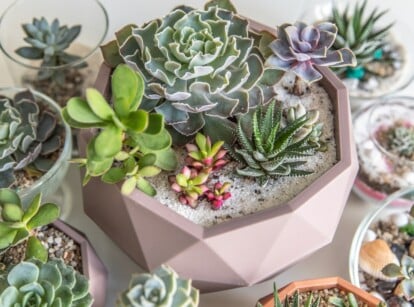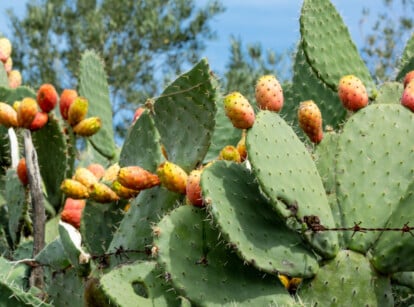37 Different Types of Unique Purple Succulents
If you are looking for something that's a little more unique to add to your garden, a purple succulent might be exactly what you need! In this article, gardening expert Melissa Strauss walks through her favorite purple succulents to add to your indoor or outdoor garden.

Contents
Creating a succulent garden can be an incredibly interesting and fulfilling project, whether you are building an outdoor rock garden, a hanging basket, or an indoor collection of these fascinating plants. Succulent plants are typically very easy to care for, with the greatest threat to their survival being overwatering.
Many succulents turn various shades of red and purple when exposed to the sun. When they turn purple, they are actually producing anthocyanins in response to sun exposure.
This chemical reaction makes for some truly stunning plants that make a wonderful addition to a collection of succulents, adding color and texture to your existing garden. Let’s take a look at some of the most popular purple succulents that can grow in a variety of different climates, and as houseplants.
Echeveria ‘Afterglow’

|
|
botanical name Echeveria ‘Afterglow’ |
|---|---|
|
|
sun requirements Full Sun to Part Sun |
|
|
hardiness zones 9-12 |
Echeveria is one of my favorite container plants, and definitely my favorite succulent. This wonderful variety is a large type, with lavender rosettes growing up to 12” in diameter. The purple leaves have a delicate ruffle to the edges and a thin pink margin that really makes them pop. Echeveria are very heat and drought tolerant, and more sun will deepen the color of this pretty plant.
Echeveria bloom in summer, and many gardeners remove the flower spikes to encourage growth, but I think the blooms are just beautiful. The spikes are about 1’ tall and branching at the ends. ‘Afterglow’ has lavender stems with deeper purple leaves and gorgeous, soft coral flowers.
Sempervivum Heuffelii ‘Artemis’

|
|
botanical name Sempervivum heuffelii ‘Artemis’ |
|---|---|
|
|
sun requirements Full Sun to Part Sun |
|
|
hardiness zones 4-10 |
This superbly hardy succulent is frost tolerant to zone 4 and has a wonderful, symmetrical shape. The tightly organized rosettes are green in the center, but turn deep purple at the ends, and the color continues to deepen into the fall, when the entire plant turns a deep eggplant shade.
This European native likes full sun and well-drained soil, but it isn’t concerned about excessive heat or frost. Its leaves are lightly dusted with fine white fuzz that protects it from heat and cold. ‘Artemis’ thrives through winter, even beneath a blanket of snow.
This succulent has yellow flowers that appear in summer, but they are terminal, and the parent plant dies after blooming. Artemis makes lots of offsets though, so there’s no shortage of baby plants to take their place.
Sempervivum Heuffelii ‘Bermuda’

|
|
botanical name Sempervivum heuffelii ‘Bermuda’ |
|---|---|
|
|
sun requirements Full Sun to Part Sun |
|
|
hardiness zones 4-10 |
If you don’t know about Sempervivum heuffelii, let me fill you in on this awesome little plant. This is the second of many on our list and as you may have seen above, with good reason. These plants are amazingly easy to grow, heat and frost tolerant, and they create offsets generously.
‘Bermuda’ is a beautiful color changing variety that turns fully purple in the winter cold. The color starts out pale green with pale purple-pink accents and white margins. The thick, fleshy leaves are arranged in a neat rosette and bloom only once before the parent plant dies, but with so many offsets, you will have these beauties year after year.
Echeveria ‘Black Prince’

|
|
botanical name Echeveria ‘Black Prince’ |
|---|---|
|
|
sun requirements Full Sun to Part Sun |
|
|
hardiness zones 9-12 |
This small stunner can be described as purple to dark brown, or even black. It can be grown indoors, but without enough sun, it will lose some of its gorgeous hue and go back to green. If you are growing north of zone 9, be sure to bring this prince indoors when the temperature drops below freezing.
‘Black Prince’ will produce a flower spike in fall and bloom with striking red flowers. Then the plant will go dormant for the winter, at which time it needs very little water. Black Prince also comes in a variegated cultivar, known as Bess Bates.
Aeonium Arboreum ‘Zwartkop’

|
|
botanical name Aeonium arboreum ‘Zwartkop’ |
|---|---|
|
|
sun requirements Full Sun |
|
|
hardiness zones 9-12 |
Known by the name Black Rose and Black Tree Rose, ‘Zwartkop’ is a tall deep red succulent whose color deepens to a nearly black, purple color in full sun. This plant needs more water than the average succulent, and rather than offsets, this plant is best propagated by cuttings.
Black Rose is tall and branching, reaching up to 4’ tall in some instances. It produces yellow flowers in summer that strike a lovely contrast with the deep foliage.
Sempervivum Heuffelii ‘Bora’

|
|
botanical name Sempervivum heuffelii ‘Bora’ |
|---|---|
|
|
sun requirements Full Sun to Part Sun |
|
|
hardiness zones 4-10 |
‘Bora’ is a beautiful color changing variety of Sempervivum heuffelii that starts out with a bright green heart early in the year and deepens to an almost blackish purple color by winter. The leaves grow in a neat rosette and have a smattering of fine cilia at the edges.
This succulent will flower after a few years, producing yellow flowers before the rosette dies off. Offsets will take its place and before long you will have a great number of these cold hardy plants.
Broadleaf Stonecrop

|
|
botanical name Sedum spathulifolium ‘Purpureum’ |
|---|---|
|
|
sun requirements Full Sun to Part Sun |
|
|
hardiness zones 5-9 |
This little award winner is an attractive and predictable plant that attracts butterflies and makes a wonderful ground cover. Broadleaf is a North American native that has very good cold tolerance and produces lots of bright yellow flowers in the late spring and into summer.
The leaves are fleshy and silvery with a purple edge to their rosette shaped clusters of fleshy leaves. It looks particularly pretty in rock gardens where it will spread and create a pretty carpet of spoon shaped leaves.
Echeveria ‘Chroma’
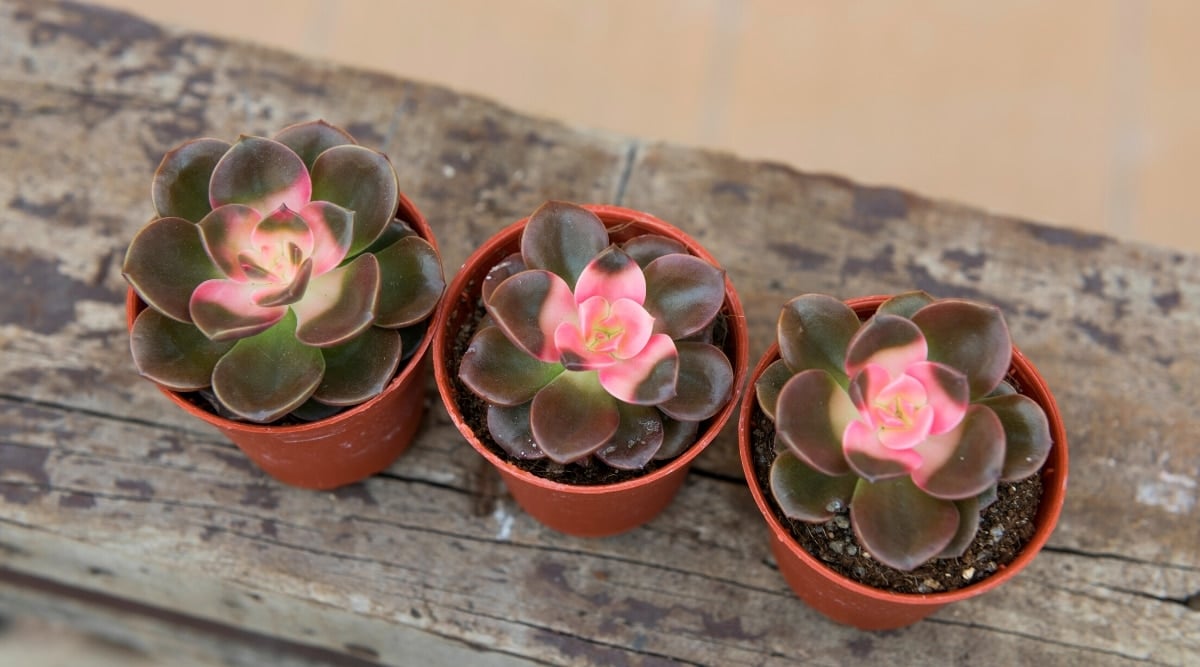
|
|
botanical name Echeveria ‘Chroma’ |
|---|---|
|
|
sun requirements Full Sun to Part Sun |
|
|
hardiness zones 9-11 |
‘Chroma’ is a wonderfully colorful, variegated variety of echeveria. I’ve included it because purple happens to be one of its many colors, but Chroma’s colors also include pink, green, apricot, gold and white. In short, it is a stunningly colorful little plant.
The rosettes are small (4” in diameter) and bell shaped. They tend to be lighter colored toward the center and deepen toward the edges, and with sun exposure. In spring, ‘Chroma’ sends up flower spikes topped with bell shaped flowers that are yellow in the center and coral colored outside.
Dragon’s Blood Sedum

|
|
botanical name Sedum spurium ‘Dragon’s Blood’ |
|---|---|
|
|
sun requirements Full Sun to Part Sun |
|
|
hardiness zones 5-9 |
‘Dragon’s Blood’, also known as Caucasian Stonecrop, is another winner of the Royal Horticultural Society’s Award of Garden Merit. This carpet like plant produces clusters of green leaves that gradually deepen from red to purple at the edges depending on sun exposure and time of year.
Sedum plants are very hardy and forgiving. They can tolerate a fair amount of neglect and are more or less pest and disease resistant. Dragon’s Blood produces pretty red flowers in spring.
Graptoveria ‘Debbie’

|
|
botanical name Graptoveria ‘Debbie’ |
|---|---|
|
|
sun requirements Full Sun to Part Sun |
|
|
hardiness zones 9-12 |
‘Debbie’ works well with others. Specifically, ‘Debbie’ has a very unique color that adds a special interest to a succulent garden, or arrangement. This echeveria hybrid has plump, rounded rosettes of leaves in a pale lavender to violet color.
This variety does quite well as a houseplant provided it has a brightly lit window and doesn’t get too much water. It produces plentiful offsets and lovely apricot flowers in spring. ‘Debbie’ makes a great container plant.
Sempervivum Heuffelii ‘Hot Lips’

|
|
botanical name Sempervivum heuffelii ‘Hot Lips’ |
|---|---|
|
|
sun requirements Full Sun to Part Sun |
|
|
hardiness zones 4-10 |
‘Hot Lips’ is a striking variety of Sempervivum heuffelii with reddish purple leaves that are edged in a pale green, almost white. Their rosette shape is dense and tightly organized such that the center appears lighter as a result of the pale edges being closer together.
These plants are amazingly cold hardy for succulents, so they are a fabulous choice for gardeners in northern zones. ‘Hot Lips’ produces yellow flowers after a few years and then the parent plant dies off. These plants winter well under an insulating blanket of snow.
Houghton’s Hybrid Kalanchoe

|
|
botanical name Kalanchoe x houghtonii |
|---|---|
|
|
sun requirements Full Sun |
|
|
hardiness zones 9-12 |
Also known as Mother of Millions and Devil’s Backbone, this interesting variety of kalanchoe is not known for its flowers, as most kalanchoe tend to be. Rather, it is beloved for its unique, narrow leaves that grow thousands of baby plantlets all along the serrated margins.
Houghtonii does bloom, however, and produces lovely stalks with bell shaped flowers that resemble a chandelier. The blooms are red, and the plant will produce them every year as long as it gets enough light.
Sedeveria ‘Jet Beads’

|
|
botanical name Sedeveria ‘Jet Beads’ |
|---|---|
|
|
sun requirements Full Sun to Part Sun |
|
|
hardiness zones 9-11 |
This hybrid between sedum and echeveria is an intensely colored small succulent. It gets its name from its habit of darkening to a nearly black shade of purple. ‘Jet Beads’ makes a great hanging container plant with its creeping habit, and it produces attractive yellow flowers in the summer.
Like both of its parent plants, Sedeveria is easy to grow and care for. It does well in a variety of light conditions but will get the most colorful if given ample sunlight. It roots easily from cuttings, all you need to do is break off a stem and push the end into moist soil.
Sempervivum Heuffelii ‘Job’s Beard’

|
|
botanical name Sempervivum heuffelii ‘Job’s Beard’ |
|---|---|
|
|
sun requirements Full Sun to Part Sun |
|
|
hardiness zones 4-9 |
This variety of Sempervivum heuffelii is greener than some of the others I’ve mentioned. Commonly called hens and chicks for its habit of producing many offspring that all cluster together, ‘Job’s Beard’ is bright, light green in the center, and the fleshy leaves are tipped with a deep purple shade.
Each fuzzy rosette blooms only once before dying and produces a long stalk of yellow and white flowers. These are easy plants to grow and in no time, you will have a whole army of rosettes.
Sempervivum ‘Killer’

|
|
botanical name Sempervivum ‘Killer’ |
|---|---|
|
|
sun requirements Full Sun to Part Sun |
|
|
hardiness zones 4-9 |
‘Killer’ is a spectacular, small hybrid Sempervivum variety. The color combination and pattern of the leaves on this plant make it one of the most fun on the list, not to mention it has a fun name.
‘Killer’ has something of a bullseye pattern, the leaves are purple at the base, green in the center, and purple at the edges, so that as they open, there appear to be concentric rings of alternating colors. A very striking specimen with great cold tolerance and visual appeal.
Sedeveria ‘Lilac Mist’

|
|
botanical name Sedeveria ‘Lilac Mist’ |
|---|---|
|
|
sun requirements Full Sun to Part Sun |
|
|
hardiness zones 8-11 |
‘Lilac Mist’ is known for its adaptability to varying light conditions. While it is not cold tolerant, its ability to survive low light conditions makes it a very good houseplant. The leaves are very plump and fleshy, and a lovely light green to lilac shade. The leaves are also fuzzy which gives the plant some additional protection from the hot sun.
Sedeveria are very drought tolerant and don’t need to be watered often. They are low maintenance, and this variety grows up to 2’ tall. In early summer, ‘Lilac Mist’ produces flowers that are typically white, but can be pink or purple as well.
Sedum Dasyphyllum ‘Lilac Mound’

|
|
botanical name Sedum dasyphyllum ‘Lilac Mound’ |
|---|---|
|
|
sun requirements Full Sun to Part Sun |
|
|
hardiness zones 5-10 |
This pretty sedum bears a striking resemblance to another popular succulent, Burro’s Tail. Although its stems don’t tend to grow as long as Burro’s Tail, they have a very similar leaf formation.
As the name implies, ‘Lilac Mound’ has a mounding habit of growth and forms a pile of these pretty little structures. The newer growth comes in green, but quickly deepens to a pretty plum color.
Mangave ‘Macho Mocha’

|
|
botanical name Mangave ‘Macho Mocha’ |
|---|---|
|
|
sun requirements Full Sun |
|
|
hardiness zones 7-10 |
Mangave plants are a relatively new hybrid creation that crosses Agave with Manfreda. The resulting plant has the aesthetic balance and sturdiness of an Agave, with the pretty color variations typical of Manfredas. These plants remain solitary until blooming, at which time they produce offsets which can be left to mound or separated into their own space.
‘Macho Mocha’ is a mid-sized plant (1’-2’ tall and wide) and its blooms are very attractive to hummingbirds. The foliage is palm-like, green in the center which fades into purple speckles and eventually, solid purple at the ends of the leaves.
Mangave ‘Mission to Mars’

|
|
botanical name Mangave ‘Mission to Mars’ |
|---|---|
|
|
sun requirements Full Sun to Part Sun |
|
|
hardiness zones 7-10 |
‘Mission to Mars’ is another variety of the intriguing hybrid Mangave species. These plants are unfussy and easy to grow, making a highly textured border or focal point. They are perennial and have excellent drought tolerance once established.
‘Mission to Mars’ grows to about 10” tall and has twice the spread. Its leaves are technically green with purple spots, but the spots become so dense in maturity that the entire plant appears deep purple with slight green spots and narrow margins.
Pachyphytum Oviferum ‘Moonstones’

|
|
botanical name Pachyphytum oviferum ‘Moonstones’ |
|---|---|
|
|
sun requirements Full Sun |
|
|
hardiness zones 10-11 |
Also known as Sugar Almonds, ‘Moonstones’ is native to Mexico where it is dormant in summer and produces pretty white and red blooms in late winter and early spring. The small, rounded leaves turn lavender in bright sun, and have a frosted appearance, making the color appear very light until wet.
Sempervivum Heuffelii ‘Mystique’

|
|
botanical name Sempervivum heuffelii ‘Mystique’ |
|---|---|
|
|
sun requirements Full Sun to Part Sun |
|
|
hardiness zones 4-10 |
‘Mystique’ is another winter hardy succulent in the Sempervivum species that is colorful and vibrant year-round. These plants like a lot of sun and good drainage, like most succulents. The difference is that they are exceptionally tolerant of cold weather.
This variety is rather large and has reddish brown leaves through the spring and summer. As the weather cools, these leaves deepen to a purple color that is almost black by the end of winter. The edges of the leaves are coated with fine white cilia.
Echeveria ‘Neon Breakers’

|
|
botanical name Echeveria ‘Neon Breakers’ |
|---|---|
|
|
sun requirements Full Sun to Part Sun |
|
|
hardiness zones 10-12 |
‘Neon Breakers’ is a striking variety of echeveria. It has ruffled leaves which are bluish in the center fading to pink at the edges, giving the center of the leaves a violet color. The shape of the leaves and the bright pink, ruffled edges set this echeveria apart.
As with all echeveria, Neon Breaker’s colors will intensify when it is given more sun. This variety is only hardy to zone 10 though, it is not cold tolerant. In spring, keep an eye out for flower spikes topped with pretty pink blooms.
Echeveria ‘Perle von Nurnberg’
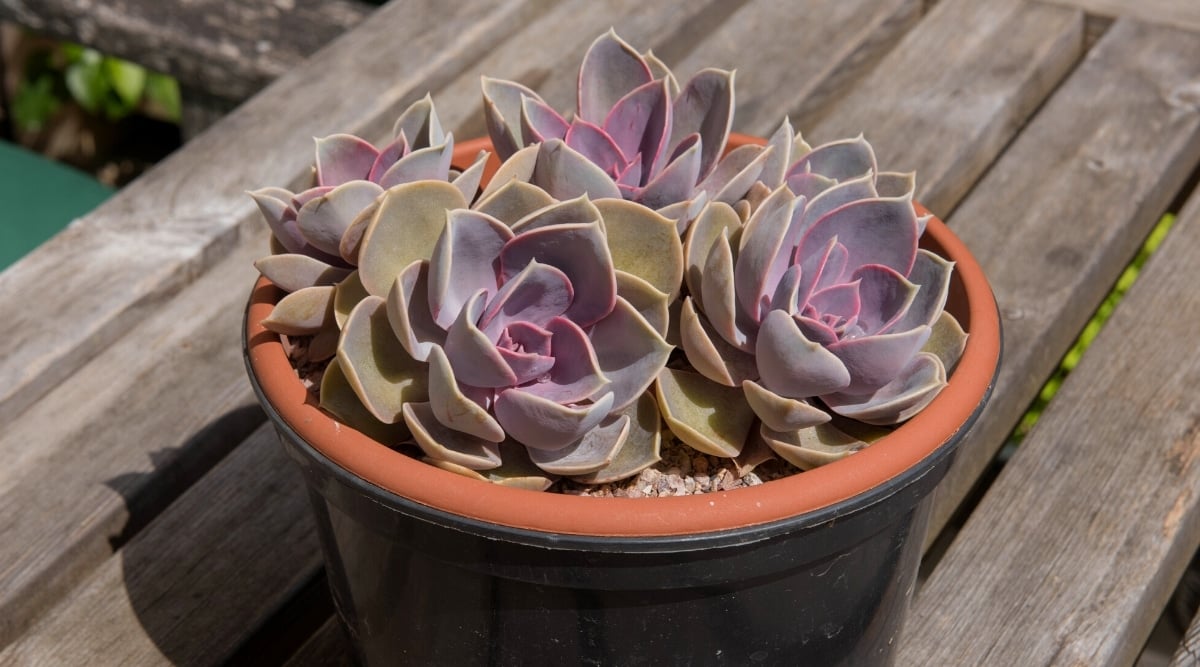
|
|
botanical name Echeveria ‘Perle von Nurnberg’ |
|---|---|
|
|
sun requirements Full Sun to Part Sun |
|
|
hardiness zones 9-12 |
‘Perle von Nurnberg’ is a beautiful variety of echeveria that differs widely in appearance from Neon Breakers just listed. Her pale blue violet leaves are a loose rosette form, and they are as smooth as porcelain.
When placed in low light, the leaves will turn a gray color, but as will most plants of its kind, it gets more colorful in the sun. In summer, Perle sends up stems with pink flowers that have yellow interiors. Echeveria do not die after blooming, and a single echeveria can live for decades if well cared for.
Sempervivum Tectorum ‘Purple Beauty’

|
|
botanical name Sempervivum tectorum ‘Purple Beauty’ |
|---|---|
|
|
sun requirements Part Sun |
|
|
hardiness zones 4-8 |
Commonly known as House Leek, ‘Purple Beauty’ is a variety of Sempervivum tectorum, which in Latin means ‘always living on roofs.’ This type of hens and chicks plant produces lots of offsets, forming clustering mounds of partially open rosettes.
They vary in color based upon the season, and typically are purple at the tips of the leaves. In mid-summer, they send up stems flanked with softly whiskered leaves. Atop these stems will bloom clusters of small pink flowers that resemble asters.
Graptopetalum ‘Purple Delight’

|
|
botanical name Graptopetalum ‘Purple Delight’ |
|---|---|
|
|
sun requirements Full Sun |
|
|
hardiness zones 10-12 |
‘Purple Delight’ is a great plant for beginners. It is easy to care for and makes a great houseplant for a sunny windowsill. Also known as Snow White, the color of this plant can range from lavender-gray to frosted white.
These plants produce white flowers with red spots and are very easy to propagate by leaf cuttings. They do need to come in in the winter months, as they are not cold tolerant below 30°F.
Hylotelephium Telephium ‘Purple Emperor’

|
|
botanical name Hylotelephium telephium ‘Purple Emperor’ |
|---|---|
|
|
sun requirements Full Sun |
|
|
hardiness zones 3-9 |
‘Purple Emperor’ is a member of the sedum family, and it is a beautiful, hardy, and easy to care for plant. It is a winner of the Award of Garden Merit from the Royal Horticultural Society, and one look will tell you why.
This variety has gorgeous aubergine-colored leaves. In late summer, ‘Purple Emperor’ produces lots of pretty pink flowers that appear in clusters, are long lasting, and maintain their attractiveness into the late fall.
Graptopetalum ‘Purple Haze’

|
|
botanical name Graptopetalum ‘Purple Haze’ |
|---|---|
|
|
sun requirements Full Sun to Part Sun |
|
|
hardiness zones 9-11 |
This softly colored Graptopetalum is easy on the eyes, and easy to care for as well. The fleshy leaves are arranged in a loose rosette and are a striking, pale gray color with lavender edges that intensify seasonally.
This variety produces lovely little flowers in spring. The flower spike is lavender, and the blooms are tiny, white, and star shaped with flecks of red on the petals.
Purple Heart

|
|
botanical name Tradescantia pallida ‘Purpurea’ |
|---|---|
|
|
sun requirements Full Sun to Part Sun |
|
|
hardiness zones 10-11 |
Purple Heart is unique on this list in its growth habit. This spidery, trailing succulent is a deep purple color, and has interesting, oblong rosette type leaf formations that make a wonderful groundcover. When they are happy, they produce pretty pinkish purple flowers in summertime.
Although they are said to be hardy only in zones 10-11, here in zone 8, mine die off in winter and come right back in spring, so they are more cold tolerant than they look, but they are not evergreen above zone 10. Also, a winner of the Award of Garden Merit from the RHS.
Echeveria ‘Purple Pearl’

|
|
botanical name Echeveria ‘Purple Pearl’ |
|---|---|
|
|
sun requirements Full Sun to Part Sun |
|
|
hardiness zones 9-12 |
‘Purple Pearl’ is a tissue culture release from Perle von Nurnberg. While it is very similar in shape, size and form to Perle, it has a deeper color, and a magenta touch to the edges. In most other respects the two plants are the same, however, Purple Pearl’s flowers are all coral.
Purple Rose Tree

|
|
botanical name Aeonium arboretum ‘Atropurpureum’ |
|---|---|
|
|
sun requirements Full Sun |
|
|
hardiness zones 9-11 |
This funky succulent goes by many names, among them are Black Rose, Purple Rose, and Black Beauty. As you can probably guess, there is nothing lilac or lavender about this plant. It is about as deep purple as it gets. These fun oxblood rosettes grow atop tall stems, looking a bit like sunflowers.
Purple Rose Tree tolerates light shade and prefers not to be overwatered. It produces small white flowers in the early summer, before it goes dormant. Water very sparingly during the summer months.
Sempervivum ‘Raspberry Ice’

|
|
botanical name Sempervivum ‘Raspberry Ice’ |
|---|---|
|
|
sun requirements Full Sun to Part Sun |
|
|
hardiness zones 4-10 |
This spidery looking plant is another highly cold tolerant succulent. Sempervivum are native to Europe and survive snowy winters with no problems. ‘Raspberry Ice’ has deep purple, smooth leaves with a sprinkling of white fuzz around the edges that resembles frost.
‘Raspberry Ice’ sends out offsets attached to long purple stems. This leggy plant increases in its purple color over time and turns entirely a deep purple black color.
Echeveria Agavoides ‘Romeo’

|
|
botanical name Echeveria agavoides ‘Romeo’ |
|---|---|
|
|
sun requirements Full Sun to Part Sun |
|
|
hardiness zones 9-11 |
Named for the legendary lover of Miss Capulet, ‘Romeo’ is a beautiful, deep burgundy variety of echeveria. Sporting spiky leaves in a tight rosette formation, this pretty plant deepens in color with more sunlight. The leaves start out a smoky green and gradually deepen to a reddish-purple shade.
‘Romeo’ does bloom, in late spring through summer, but his flowers are smaller than most varieties. The flowers are red and tipped with yellow. The real star of the show here are the plump leaves with their brilliant colors.
Pleiospilos Nelii ‘Royal Flush’
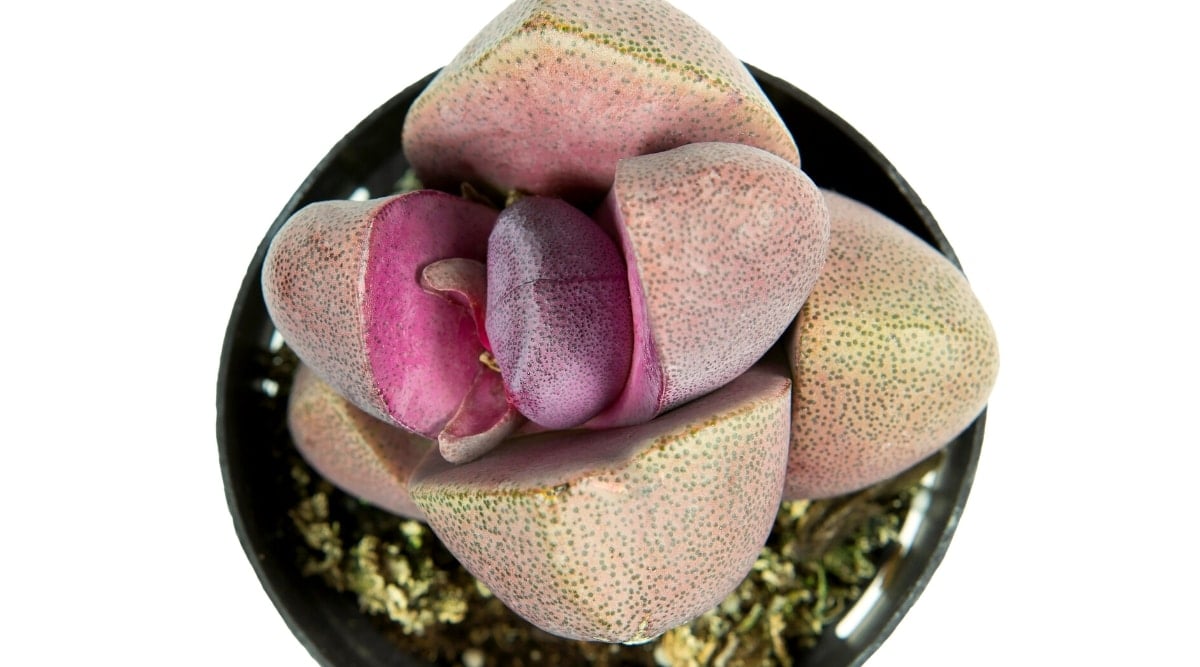
|
|
botanical name Pleiospilos Nelii ‘Royal Flush’ |
|---|---|
|
|
sun requirements Full Sun to Part Sun |
|
|
hardiness zones 9-11 |
Commonly called Split Rock plants, Pleiospilos are funny little succulent plants that stay small and always remind me of the rock trolls from the movie Frozen, take a look, it will be hard to unsee! These little guys only reach about 3” tall and are native to South Africa.
‘Royal Flush’ is a soft greenish purple color, and in early spring it will produce the prettiest little flowers. The blooms are bright pink with a yellow center and resemble small daisies. This is a fun little novelty of a plant and is very easy to care for. It can survive in many different light conditions, including artificial light.
Lithops Optica ‘Rubra’

|
|
botanical name Lithops Optica ‘Rubra’ |
|---|---|
|
|
sun requirements Full Sun to Part Sun |
|
|
hardiness zones 9-12 |
Similar to Pleiospilos, Lithops are called Living Rock plants because they do indeed resemble rocks! Rubra is a deep purple color, and two round, fleshy lobes open to reveal a pretty white flower in late summer.
‘Rubra’ needs lots of sunlight. Due to its original environment, this plant is dormant in summer. It blooms at the beginning of its growing season, and needs more water in the winter, although it doesn’t need much water year-round. Overwatering is deadly to this plant.
Othonna Capensis ‘Ruby’s Necklace’
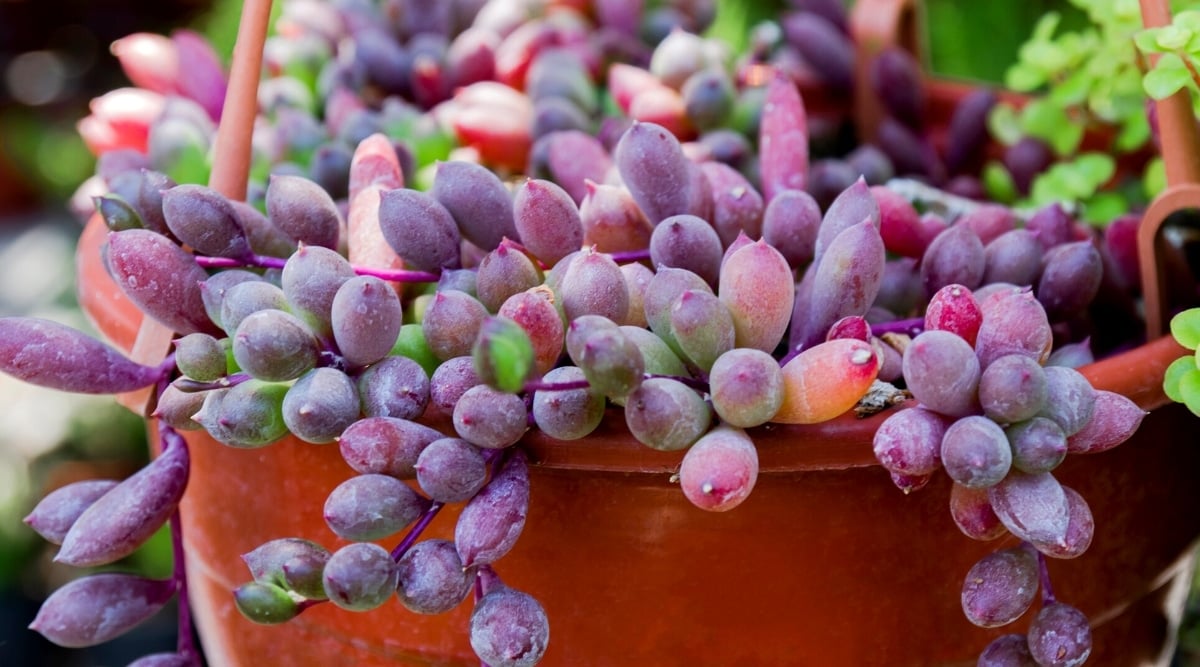
|
|
botanical name Othonna capensis ‘Ruby’s Necklace’ |
|---|---|
|
|
sun requirements Full Sun to Part Sun |
|
|
hardiness zones 9-11 |
If there is one plant on this list that I am adding to my Christmas list, it’s definitely ‘Ruby’s Necklace’. This gorgeous hanging succulent is a member of the Aster family, so it has pretty little flowers that resemble yellow daisies. The leaves are green with a purple blush that deepens with more light and the stems are brilliant magenta purple.
This trailing plant can be difficult to keep happy indoors, but it’s not impossible. Also called String of Pickles, this plant will need to get as much light as you can give it when grown indoors, and full to part sun outdoors. Standard succulent watering rules apply, overwatering will cause root rot, so a little neglect in this department is a must.
Santa Rita Prickly Pear

|
|
botanical name Opuntia santarita |
|---|---|
|
|
sun requirements Full Sun |
|
|
hardiness zones 7-11 |
This pretty prickly pear is beautiful and edible, too! Santa Rita is an ornamental cactus with round, colorful, fleshy pads that add beauty to the outdoor garden year-round. These guys are a bit big to grow indoors. Fortunately, they are hardy in a wide range of climates.
The paddles start out brilliant jade colored and gradually take on a bright violet shade in the sun. Sunny yellow blooms show up in spring creating a striking contrast and making this a very showy focal point in any succulent garden. These plants are easy to care for and truly stunning.
Sedeveria ‘Sorrento’

|
|
botanical name Sedeveria ‘Sorrento’ |
|---|---|
|
|
sun requirements Full Sun to Part Sun |
|
|
hardiness zones 10-12 |
‘Sorrento’ is another Sedum x Echeveria hybrid, which means that it is very easy to grow and just as easy to propagate. They are not exceptionally cold tolerant, but they are ok outdoors down to 32°F. These plants shed some leaves in the winter, but they will return in spring.
Bright sunlight is a must, and low watering. The more sun, the deeper the color will get starting out green and gradually darkening to a deep red-violet. These plants are very drought tolerant once established and are difficult to kill unless they get too much water.
Final Thoughts
Purple succulents are a beautiful way to add interest and brilliance to your succulent garden. Many of them do very well indoors as house plants, and most of them are extremely easy to care for, in fact they mainly like a good deal of neglect.
If you are looking for a low maintenance plant that will surprise and delight with its bold and evolving color palette, these purple succulents are certain to inspire and enchant.






